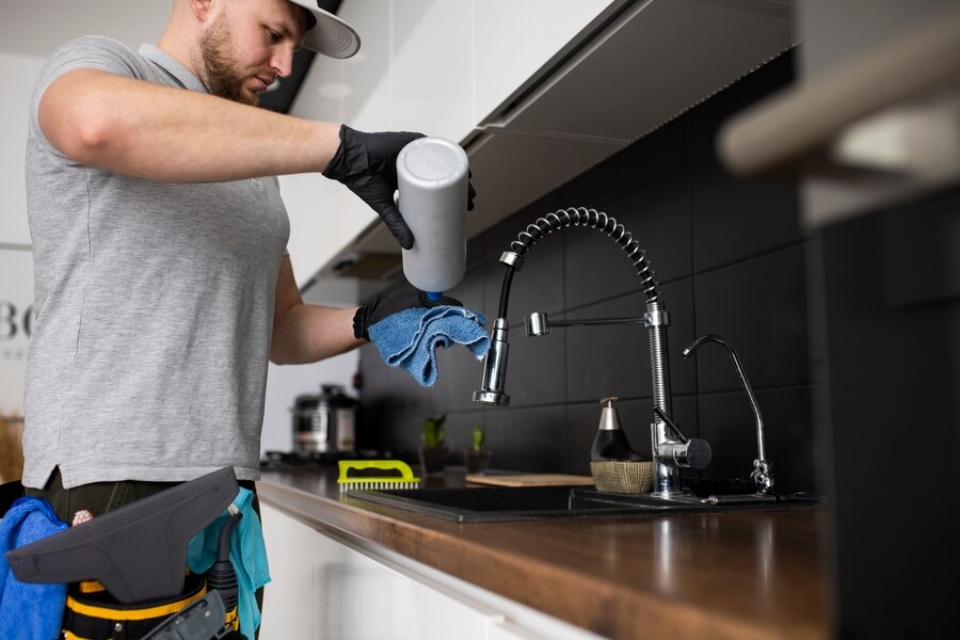Composite sinks are a popular choice for modern kitchens due to their durability, aesthetic appeal, and resistance to stains. However, keeping their pristine situation calls for proper cleansing strategies. In this comprehensive guide, we will explore the most effective methods to clean and maintain your composite sink kitchen, ensuring it remains spotless and functional for years to come.
Key Takeaways
- Daily rinsing and wiping down the sink with moderate dish soap save you stains and filth buildup.
- Weekly deep cleaning with baking soda and vinegar helps remove stubborn stains and disinfect the sink.
- Use a combination of hydrogen peroxide, baking soda, and commercial cleaners for tough stains.
- Regular polishing with olive oil or commercial polish restores shine and protects the surface.
- Avoid harsh chemicals, use a sink grid, clean spills immediately, and avoid extreme temperatures to maintain the sink’s integrity.
Composite sinks are made from a combination of materials such as granite, quartz, and acrylic resins, and offer a sleek and stylish addition to any kitchen. These sinks are recognized for his or her robustness and capability to resist each day’s wear and tear. However, like any kitchen sink fixture, sinks need regular cleaning to prevent the buildup of grime, stains, and bacteria. This article will provide you with detailed, step-by-step instructions on how to clean your composite sink effectively, using both natural and commercial cleaning products.
Materials Needed for Cleaning
Before diving into the cleansing manner, acquire the important materials. You will need:
- Mild dish soap
- Baking soda
- White vinegar
- Soft cloth or sponge
- Non-abrasive scrub pad
- Soft-bristle brush
- Microfiber towel
- Olive oil (optional for polishing)


Maintaining Daily Clean Routine
Maintaining a composite sink’s cleanliness starts with a daily routine. After each use, rinse the sink thoroughly with warm water to remove any food particles and soap residue. Use a soft cloth or sponge with mild dish soap to wipe down the sink’s surface. This routine helps prevent stains from the kitchen Cabinets and sinks.
- Rinse the Sink: Start by rinsing the sink with warm water to remove loose debris.
- Apply Dish Soap: Use a soft cloth or sponge with mild dish soap to clean the surface.
- Wipe Down the Surface: Gently wipe down the entire sink, paying extra attention to corners and edges.
- Rinse Thoroughly: Rinse the sink again with warm water to remove any soap residue.
- Dry with a Towel: Use a microfiber towel to dry the sink, preventing water spots.
Maintaining Clean habits Weekly
To keep your composite sink in top condition, perform a deep cleaning once a week. This process helps remove any stubborn stains and keeps the sink looking new.
- Create a Baking Soda Paste: Mix baking soda with a small amount of water to shape a thick paste.
- Apply the Paste: Spread the baking soda paste evenly over the sink’s surface, focusing on stained areas.
- Scrub with a Non-Abrasive Pad: Use a non-abrasive scrub pad to gently scrub the sink, following the grain of the composite material.
- Rinse with Vinegar: Pour white vinegar over the baking soda paste. The reaction will help lift stains and disinfect the sink.
- Rinse Thoroughly: Rinse the sink with warm water to get rid of any residue.
- Dry with a Towel: Dry the sink with a microfiber towel to prevent water spots.

Remove and Clean Stubborn Stains
For tough stains that don’t come off with regular cleaning, try these methods:
- Hydrogen Peroxide and Baking Soda: Create a paste with hydrogen peroxide and baking soda. Apply it to the stained area, let it sit for 15 minutes, then scrub with a soft-bristle brush.
- Vinegar and Baking Soda: Apply a mixture of vinegar and baking soda to the stain. Let it sit for 10 minutes before scrubbing gently with a soft-bristle brush.
- Commercial Cleaners: Use a composite sink cleaner recommended by the manufacturer. Follow the instructions carefully to avoid damaging the sink.
Polishing the Sink
Polishing your composite sink can help restore its shine and protect its surface. Use olive oil or a business composite sink polishing.
- Clean the Sink: Ensure the sink is clean and dry before polishing.
- Apply Olive Oil: Apply a small amount of olive oil to a soft cloth.
- Buff the Surface: Gently buff the sink’s floor in circular motions.
- Wipe-Off Excess: Use a clean microfiber towel to wipe off any excess oil.
Preventive Maintenance
Preventing damage and stains is key to maintaining your composite sink. Here are some tips:
- Avoid Harsh Chemicals: Do not use bleach, ammonia, or abrasive cleaners on your composite sink.
- Use a Sink Grid: Place a sink grid at the bottom to prevent scratches from pots and pans.
- Clean Spills Immediately: Wipe up spills, especially acidic substances like lemon juice and vinegar, to prevent staining.
- Avoid Extreme Temperatures: Do not expose the sink to extreme heat or cold to prevent cracks and discoloration.
Frequently Asked Questions (FAQs)
Can I use bleach to clean my composite sink?
No, you should avoid using bleach or other harsh chemicals on a composite sink as they can damage the surface and cause discoloration.
What should I do if my composite sink gets scratched?
Minor scratches can often be buffed out with a non-abrasive pad and some baking soda paste. For deeper scratches, consult the sink’s manufacturer for repair recommendations.
Is it safe to use vinegar to Clean the composite sink?
Yes, vinegar is safe and effective for cleaning composite sinks. It helps to disinfect and remove stains when used in combination with baking soda.
How often should I polish my composite sink?
Polishing your composite sink once a month is usually sufficient to maintain its shine and protect the surface.
Can I use a steel wool pad to scrub my composite sink?
No, avoid using steel wool or any abrasive pads that can scratch the surface of the composite sink. Instead, use a non-abrasive scrub pad or a gentle-bristle brush.
Conclusion
Maintaining the beauty and functionality of your composite sink kitchen is simple with the right cleaning techniques and preventive measures. By following the steps outlined in this guide, you can ensure your sink remains a stunning centerpiece in your kitchen for years to come. Regular cleaning, along with occasional deep cleaning and polishing, will keep your composite sink looking and performing its best. Remember, consistency is key to preserving the longevity and appearance of your sink. Happy cleaning!

